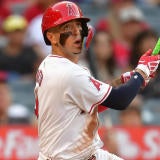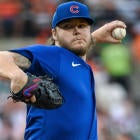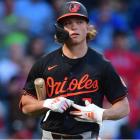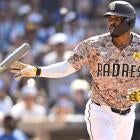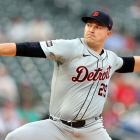- Draft Prep Tiers: C | 1B | 2B | SS | 3B | OF | SP | RP
- Heath's Sleepers 2.0 | Breakouts 2.0 | Busts 2.0
- Scott White's Top 100 prospects | Sleepers 2.0 | Breakouts 2.0 | Busts 2.0
Generally speaking, you know what you need on Draft Day when building your Fantasy team: Good players. If every one of you would just use the "Draft Good Players" strategy, we'd be out of a job.
Unfortunately – well, fortunately for me – it's not quite that simple. Especially in Rotisserie leagues, where you need to build a team that can compete across 10 separate but interdependent categories at once. You can just slap a team together based on rankings, but you might find that approach leaves you short in one category, while overloaded at another.
You need to know what your targets are, and we can get an idea of that by looking back at last season. Barring a drastic change in the league-wide landscape, last year's results should give you a pretty good idea of what to expect from 2018. I took the results from every 12-team CBS Fantasy Rotisserie league last season to create these aggregate standings. For hitting categories, here are the average results for every Roto league in 2017:
| | AVG | HR | R | RBI | SB |
| 1 | 0.2546 | 247 | 905 | 871 | 73 |
| 2 | 0.2586 | 268 | 952 | 916 | 88 |
| 3 | 0.2612 | 277 | 980 | 945 | 98 |
| 4 | 0.2632 | 288 | 1000 | 971 | 106 |
| 5 | 0.2649 | 294 | 1020 | 988 | 113 |
| 6 | 0.2665 | 302 | 1037 | 1005 | 119 |
| 7 | 0.2682 | 309 | 1052 | 1022 | 125 |
| 8 | 0.2698 | 316 | 1070 | 1035 | 131 |
| 9 | 0.2715 | 322 | 1084 | 1054 | 137 |
| 10 | 0.2734 | 330 | 1100 | 1068 | 145 |
| 11 | 0.2759 | 340 | 1118 | 1087 | 154 |
| 12 | 0.2794 | 356 | 1148 | 1121 | 168 |
So, there are your targets. a .280 average, 356 home runs, 1,148 runs, 1,121 RBI, and 168 steals were what you needed to win each hitting category last season, on average. You don't need to be in first place in all five categories, of course, but it's good to know what you're aiming for.
You can put your lineup together any way you want. You can invest heavily in power hitters or steal specialists if you want, or go with a balanced approach, but at the end of the day, you want to compete in as many categories as possible. And it helps to know which hitters help you in which categories, and how much.
To figure that out, you can use standings points gained. It's a metric that attempts to put a specific numeric value on how much a pitcher helps you win in Rotisserie. As you can see, moving up one point in the standings in home runs takes about eight long balls. For runs and RBI, it's more like 20.
(It actually requires calculating the slope of each data set, which you can read about here. It was an invaluable resource for this piece.)
Each standing point gained is exactly what it sounds like: it moves you up one point in the standings. There are questions of replacement level, but for the purposes of this exercise, we just went with raw numbers.
The point of this exercise is to give you targets to shoot for in each category as you build your team, as well as to show how much individual hitters contributed in each category last season. Here's how the top-10 hitters from 2017 got there:
The individual numbers will shift from one year to the next, but this should be a pretty good guide for the 2018 season.
Batting average

We'll start with the two categories that probably have the most independent value: Batting average and stolen bases. Every home run contributes to the RBI and run categories, but there are plenty of hits that only help you in batting average. That means there are more one-category specialists in batting average than elsewhere. Keep this in mind when you're building your team, because while someone like Joe Mauer (.305 average in 2017) or DJ LeMahieu (.310) may not do much else, they can help make up for the likes of Joey Gallo or Rougned Odor, productive players who are drags on a specific category.
Of course, the problem with batting average is it can be hard to pull yourself out of a midseason hole, especially because you can't really limit your at-bats the way you might be able to limit your innings to make up for a lacking rate stat. If you have to punt in one place, average is probably the place to go.
Steals
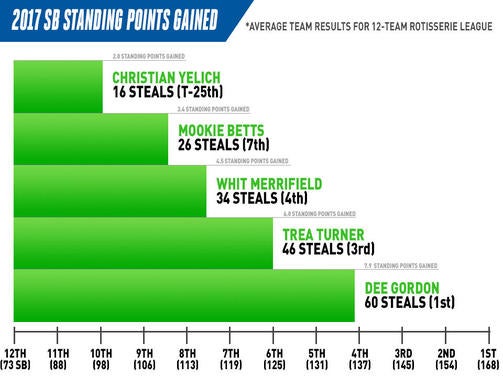
There are some Fantasy players who choose to just target mid-level stolen bases guys who contribute elsewhere, avoiding specialists like Dee Gordon or (especially) Billy Hamilton. However, 15-20 steal guys tend to have more variance from one year to the next, and if more than one of them fails to hit expectations, you can pretty quickly find yourself slipping down the standings.
Building around one high-level base stealer carries the risk that one injury can spoil your season, so there's risk there too. However, Gordon, Hamilton, and Trea Turner should all be easy bets for 50-plus steals next season assuming health, which can singlehandedly move you from last place to fifth or sixth. What's nice about grabbing one of the elite base stealing options is, you almost don't have to worry about the category with the rest of your team. If you had Gordon last season, the rest of your starting lineup needed to average a mere 7.3 steals per player to wind up in first place.
Home runs

Compare homers to steals, and you see why nabbing one of those elite speedsters is so valuable. If you had Giancarlo Stanton last season, the rest of your lineup still needed to average 21.7 homers to win the category. Stanton helps, but he can only do so much. The good news is, homers are also a lot easier to find than steals, with more than 80 players managing at least one-third of Stanton's total in 2017.
Of course, just because you don't need specialists in homers doesn't mean someone like Stanton isn't hugely valuable, and that's precisely because every home run actually counts three times in Roto; as a run, and an RBI as well. And even as a hit for average. The best home run hitters tend to double as the best RBI contributors, and they tend to score a whole bunch of runs, too. In this way, power hitters are a lot like the best pitchers: You target them for their skill sets, not for their contributions in any one specific category.
RBI
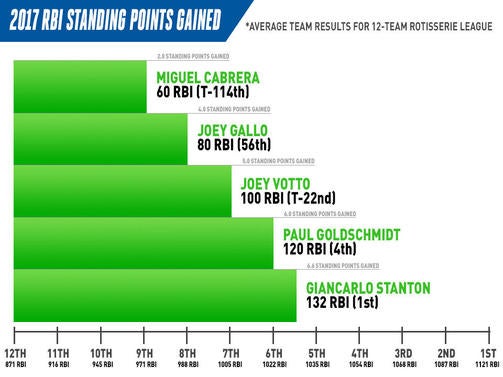
Predictably, Stanton led the way in both RBI and homers, and he's a pretty good bet to do the same in 2018 in the middle of that terrifying Yankees' lineup. You obviously need plenty of RBI to compete as well, but the good news is, as stated above, if you've done a good job of acquiring homers, you're going to have plenty of RBI too. If a player is in the lineup every day, it's hard not to get at least 70 RBI, so building from there is your goal.
Joey Gallo is a good example of one power hitter who isn't a huge contributor in RBI, because he just doesn't make a lot of contact. Putting the ball in play increases your chances of driving in runs, so Three True Outcomes (walks, homers, and strikeouts) hitters tend to underperform in RBI.
Runs

As with RBI, most everyday players are typically going to get to 60-70 runs, though that's obviously dependent on lineup order. Runs are less tied to home runs than RBI, but runs also tend to be more tied to average and steals, so there aren't a ton of pure specialists in this category either. In fact, because runs are related to getting on base and advancing on the bases, as well as scoring on your own long balls, this can be the least independent category. If you fill out the other four well enough, you probably won't need to worry about runs so much. They are products of the other things hitters do as much as anything.


